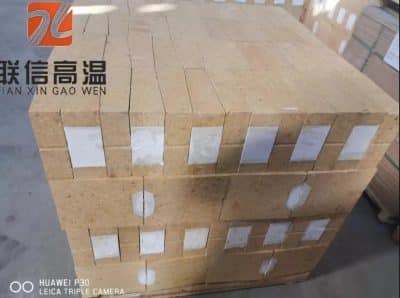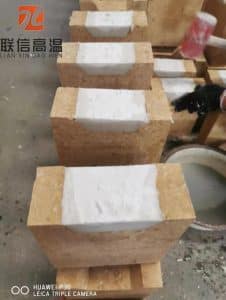The functions and characteristics of high-alumina composite bricks are high refractoriness, high load softening temperature, strong slag resistance, etc., and its uses include industrial furnace linings, high-temperature equipment components, etc.

Functions and characteristics of high alumina composite bricks
Functions and characteristics of high-alumina composite bricks:
High refractoriness:
The refractoriness of high-alumina composite bricks is higher than that of clay bricks, and they can be used for a long time at 1300℃-1550℃ without erosion and wear.
Due to the high content of Al2O3 in high-alumina composite bricks, their refractoriness can reach 1750~1790℃, which is a high-grade refractory material.
High-alumina composite bricks can remain stable at high temperatures and will not melt, soften or expand, which makes them have a long service life in high-temperature environments.
Al2O3 in high-alumina composite bricks is a high-hardness compound with a melting point of 2054℃, which provides high-alumina bricks with excellent refractory properties.
The higher the Al2O3 content in high-alumina composite bricks, the higher their refractoriness is usually, and the refractoriness of the special high-alumina brick LZ-80 grade is particularly outstanding.
High load softening temperature:
The load softening temperature of high-alumina composite bricks is higher than that of clay bricks, but not as high as that of silica bricks, generally between 1420℃-1550℃.
High-alumina composite bricks are not easy to deform at high temperatures and can support the structure of the entire furnace, which is one of the important indicators to measure the quality of high-alumina bricks.
High-alumina composite bricks have high Al2O3, low impurities, and less fusible glass, so the load softening temperature is higher.
Strong slag resistance:
High-alumina composite bricks can resist the erosion of acidic slag and alkaline slag, and are suitable for kilns with acidic and alkaline media.
There is more Al2O3 in high-alumina composite bricks, which is close to neutral refractory materials and has good slag resistance.
The slag resistance of high-alumina composite bricks enables it to protect the furnace body from erosion when smelting some media with higher melting points.
High compressive strength:
The compressive strength of high-alumina composite bricks is generally between 50-80Mpa, which ensures the stability of the kiln during operation.
High-aluminum composite bricks contain a large amount of mullite, and the main component of mullite is also Al2O3, which improves the stability of the product.
High stability:
High-aluminum composite bricks can maintain the stability of the wall under high temperature environment, ensuring safe and stable work.
The sintering expansion phenomenon of high-aluminum composite bricks is affected by the Al2O3-SiO2 binary system. The secondary mullite begins at 1200℃ and is completed between 1400-1500℃, which helps to improve its stability at high temperature.
Good wear resistance:
High-aluminum composite bricks are hard and have very good wear resistance. They can slow down the wear of the surface and increase the service life.
Uses of high-aluminum composite bricks:
Industrial furnace lining:
High-aluminum composite bricks are widely used in the lining of high-temperature equipment such as furnaces, kilns, converters, electric furnaces, heat treatment furnaces, etc. to meet the use requirements under high temperature conditions.
High-temperature equipment components:
High-aluminum composite bricks are used to build the lining of high-temperature equipment such as steelmaking electric furnaces, glass melting furnaces, cement rotary kilns, etc., which can withstand high temperatures and resist chemical erosion.
Hot blast furnace lining:
High alumina composite bricks are particularly suitable for the lining of large and medium-sized hot blast furnaces, and can provide conditions for high-temperature creep, strong corrosion resistance and good thermal shock stability.
Specific areas of kilns:
High alumina composite bricks are selected according to different levels and temperature bands to adapt to the production environment of kiln linings.
Metallurgical industry:
High alumina composite bricks play an important role as an indispensable high-temperature refractory material in the steel, metallurgy, chemical, ceramic and other industrial fields.
Regenerative checker bricks:
High alumina composite bricks are widely used as open-hearth regenerative checker bricks, plugs for pouring systems, nozzle bricks, etc. These applications reflect their good heat resistance and corrosion resistance.

Functions and characteristics of high alumina composite bricks
In summary, high alumina composite bricks play a vital role in the high-temperature industrial field with their excellent high-temperature resistance, good slag resistance and stable physical properties. With the continuous advancement of technology and the improvement of production quality, high alumina composite bricks will continue to provide strong support for the development of the high-temperature kiln industry in the future.
